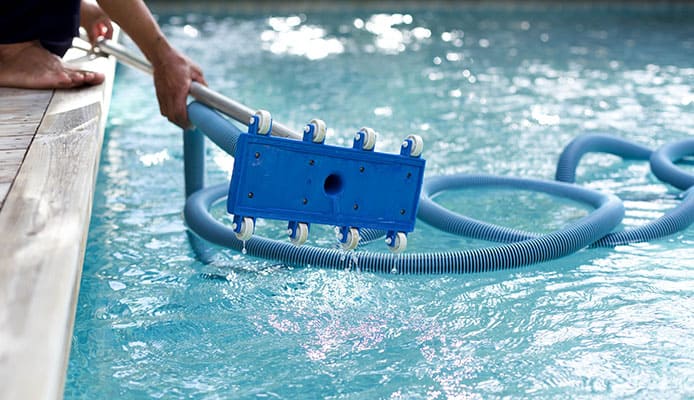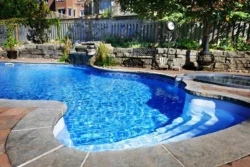Although a majority of people today use automatic cleaners, some of us still use a manual pool vacuum. It might seem counter-intuitive, as automatic cleaners can make your job much easier. However, in some cases, manual vacuuming can be a better option. For instance, automatic cleaners can’t do much when it comes to algae and other stubborn gunk.
In the following text, we’ll shed some light on the manual pool vacuum and explain how to properly use it to clean your pool. After that, we’ll also touch on automatic cleaners and discuss whether they are worth the investment or not.
Table of Contents
Components of a Manual Pool Vacuum
Another benefit of a manual pool vacuum is that you can pick the individual components all by yourself. That way, you don’t have to pay for extra features you probably won’t need. Also, you can buy components that best suit the size and shape of your pool.
Head
The most important part of a manual pool vacuum system is the vacuum head itself. Since the whole system shouldn’t cost you too much, we recommend spending the majority of your budget on the head. There are quite a few different designs, so we suggest that you do a bit of research first.
For instance, you should take the shape of your pool into account. If you have a rectangular pool, we recommend you look into rectangular vacuum heads. They’re usually cheaper, and they have rollers that can help you vacuum in a straight line.
On the other hand, if your pool is rounded, we suggest you take a look at triangular heads. Even though they work with rounded edges, the pointed tips can help you get into every nook and corner of your pool bottom.
Telescoping Pole
Depending on the size of your pool, you might be able to utilize the surface cleaning pole for vacuuming. However, for larger and deeper pools, we recommend a sturdy telescopic one.
Even though you can find some high-quality plastic poles, aluminum has the best balance of sturdiness and weight. Also, you might want to get a three-piece pole. You can keep it short for surface work and extend it when you need to vacuum.
Vacuum Hose
When choosing a hose for your manual pool vacuum, there are a few things to keep in mind.
First of all, the hose itself should be made out of ribbed PVA, so that it doesn’t tangle itself in the pool. Also, some models have swiveling cuffs to help you turn the head around while you vacuum. Finally, think about investing in a set of hose clamps to ensure a proper seal throughout the vacuuming process.
Vacuum Plate
If you want to keep your skimmer inlet and filter intact, we recommend using a vacuum plate instead of jamming the hose directly in your inlet and having to turn your pump off.
Also, keep in mind that you need a plate with a slightly larger diameter than your skimmer basket. Fortunately, most vacuum plates specify which baskets they’re suited for.
And if your vacuum hose doesn’t have a bypass valve, you can find a vectrol plate with a bypass valve built-in.
How to Use a Manual Pool Vacuum
Step 1. Preparing the Manual Pool Vacuum
To start off, you should assemble the manual pool vacuum system. Attach the vacuum hose to the head and make sure it’s secure. Feel free to use a hose clamp for extra pressure on the cuff.
Then, connect your pole to the vacuum head and submerge it in the water. At this point, we suggest you extend the pole to your desired length and try moving the vacuum across the bottom of your pool to ensure nothing is tangled up. If everything’s moving without a problem, you can start priming the vacuum.
To do that, you need to get all the air out of your vacuum head and hose. Find a water jet close by and connect it to the other end of your hose. The water will flush all the air out of your vacuum, and you’ll notice bubbles coming out of the vacuum head. When the bubbles stop popping up, the vacuum should be primed and ready to go.
Step 2. Preparing the Pump
When you disconnect the hose from the water jet, make sure not to keep the hose out of the water for too long. Keep the hose as low as possible before you connect it to the suction. If you raise the hose too high up, you risk getting air pockets in it.
If you have a vacuum plate, place it on top of your strainer basket. After that, you just need to connect the hose to the vacuum plate. In addition, you can use a hose clamp to ensure no air pockets get between the hose and the vacuum plate.
On the other hand, if you don’t have a vacuum plate, you have to remove the strainer basket first. After that, you just have to plug your hose directly to the suction port at the bottom of the skimmer.
However, we strongly advise you not to go this route, since you risk damaging your filter with large debris that might fall in while the strainer basket is off. Besides that, you can ruin your suction pump with an air pocket.
Step 3. Vacuuming the Pool Surface
If everything went according to plan, the vacuum head should stick to the bottom of the pool.
Go back and forth along the bottom, making sure not to miss any spots. Also, you might lose vacuum at some point. So, if you feel the vacuum head releasing from the bottom of the pool, you have to go back to the first step. If not, just keep vacuuming until you feel satisfied with the results.
After that, all that’s left to do is disconnect the vacuum, return the strainer basket, and drain all of the water out of the vacuum system. Also, we advise you to wash the vacuum head thoroughly after each use, to prevent any algae from spreading and ruining it.
Should You Get an Automatic Pool Vacuum?
Much like washing your clothes by hand, the manual pool vacuum has become somewhat outdated. Although manual vacuuming can help in some rare cases (when the algae are stuck, for instance), most people prefer to use an automatic cleaner instead. After all, pool cleaning is a chore like any other, and not everyone has the time or energy for it. Besides that, who needs them today, when robotic cleaners are available?
On the other hand, these robotic cleaners can be quite expensive. If you don’t mind the hefty price tag, we say go for it. And if you do, maybe it’s better to look into some cheaper options. For instance, we suggest that you get a pressure or a suction vacuum.
However, it’s up to you to decide. Whatever method you choose in the end, the results will be more or less the same. As long as you don’t rely on the filter to do all the cleaning and vacuum your pool on a weekly basis, you can’t go much wrong.
Types of Automatic Pool Vacuums
In case you decide to pay a little more and buy an automatic cleaner, here’s what the current market has to offer:
Suction Vacuums
Suction vacuums are by far the cheapest of the three. We use them for dirt, leaves, and other debris. This type of vacuum is small, light, and quite simple. It’s quite easy to install, and you can easily fix it yourself in case it breaks down.
It uses the pool’s filtration system and pump, which can be both an advantage and a disadvantage. On one hand, you don’t have to purchase a new pump. Still, if the pool’s filtration system is weak, the suction vacuum will work poorly as well.
Pressure Vacuums
A pressure vacuum requires the purchase of an additional booster pump. Besides that, to install it, you need to remodel the whole pool.
Even though it’s a bit complicated, this machine will clean the entire pool in about two hours. It will pick up the large debris and collect it in a bag, all the while filtering the water.
Robotic Vacuums
As we mentioned previously, a robotic vacuum will set you back significantly. However, what you pay is what you get. A robotic cleaner works completely wirelessly and independently from your other pool equipment. You don’t need to purchase any additional pumps or filters. The robotic vacuum is typically remote-controlled and totally programmable.
On the other hand, the robotic cleaner can be quite difficult to repair. So, if anything goes wrong, you’ll most likely have to call an expert for help. In addition, it’s quite heavy and thus difficult to remove.
Bottom Line
We hope this tutorial taught you how to use a manual pool vacuum. As you can see, it’s not that difficult, it just takes a bit of getting used to.
If you have any inquiries when it comes to pool maintenance, make sure you contact Pool Pros WA 0499831557. We are a pool-servicing company based in Wellard, WA, with over 10 years of experience in the field.
And remember, regular maintenance is a must when you have a swimming pool. Luckily, thanks to today’s technology, pool cleaning has never been easier. It doesn’t matter if you end up using a manual pool vacuum or an automatic one, as long as you keep the pool clean.







